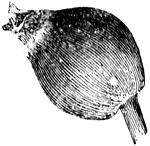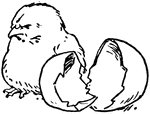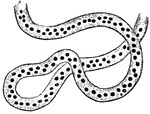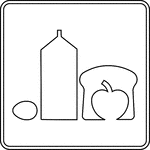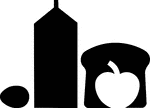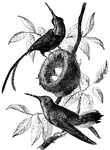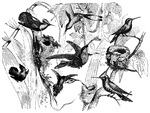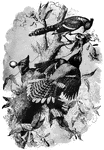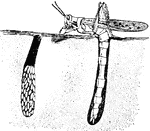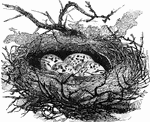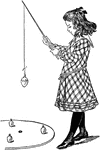
Angling for Easter eggs
"The endeavor of each player is to insert his hook through the ribbon loop on one of the eggs and lift…

Colorado Beetle Eggs
"The Colorado Beetle is a beetle first described by Thomas Say, in 1824, from specimens found by him…

Dung Beetle
"A black insect, with brilliant metallic blue or purple reflections on the under side, and well known…
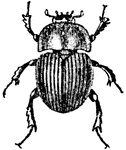
Dung Beetle
"A black insect, with brilliant metallic blue or purple reflections on the under side, and well known…

Pine Beetle Stages
This illustration shows the destructive pine-bark beetle: a, adult beetle, enlarged; b, adult, natural…

The Life Cycle of the Asparagus Beetle
Also known as crioceris asparagi. A-Beetle; B-Egg; C-Newly hatched larva; D-Full-grown larva; E-Pupa

Bessemer Converter
"a Bessemer converter, which is an egg-shaped furnace built of wrought iron plates and lined with a…
Blastoderm of a Chick
Vertical section of blastoderm of chick (1st day of incubation). S, epiblast consisting of short columnar…
Blastoderm of an Egg
Vertical section of area pellucida and area opaca (left extremity of figure) of blastoderm of a fresh…
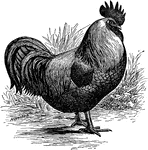
Silver Gray Dorking Cock
Dorkings are well known for their egg and meat production. The breed is very docile, but can have tendencies…

Single-Comb White Leghorn Cock
"Leghorns are the best known of the egg-producing varieties or Mediterranean class. They are the premiers…
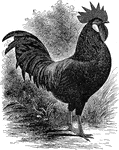
Black Minorca Cockerel
The Minorcas are similar to the Leghorns, with their main value being egg-producing. The produce less…
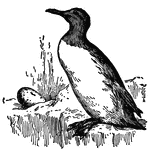
Common Guillemot
The Common Guillemot (Uria troile) is a member of the auk family. It breeds on all rocky coasts of the…

Comparative view of the size of the eggs of different animals
1, Epyornis; 2, Ostrich; 3, Cassoway; 4, Wild Goose; 5, hen; 6, Pigeon; 7, Humming-bird; 8, Eagle; 9,…
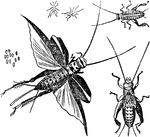
House Cricket
"House Cricket (Gryllus domesticus): a, eggs; b, young just hatched; c, full-grown larva; d, pupa; e,…

Egg Plunged in Fresh and Salt Water
An egg dropped in fresh and salt water to show the properties of density.
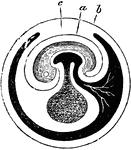
Fecundated Egg
Fecundated egg with allantois nearly complete. Labels: a, inner layer of amniotic fold; b, outer layer;…
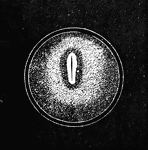
Impregnated Egg
Impregnated egg, with commencement of formation of embryo; showing the area germinativa or embryonic…
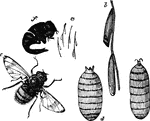
Breeze Fly
"a, eggs of the Breeze-fly; b, the same magnified; c, larva, or bot; d, chrysalis; e, perfect insect;…
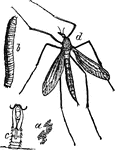
Crane Fly
"Crane-fly (Tipula oleracea): a, eggs; b, larva; c, pupa case as left by the insect, sticking out of…

Gordian Worm
"The Young Variable Gordius, after escaping from the egg. a, the worm beginning to protrude the oral…

Gordian Worm
"The Young Variable Gordius, after escaping from the egg. b, the first circle of hooklets bordering…

Gordian Worm
"The Young Variable Gordius, after escaping from the egg. c, complete protrusion of both circles of…
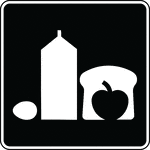
Grocery Store, Black and White
This sign is used to indicate that a grocery store is located nearby.

Pair of Silver-Spangled Hamburgs
Hamburgs are considered to be excellent egg producers. They are small in size and are capable of flight.

Night Hawk
Found in America, Mexico and the West Indies, this species averages nine to ten inches in length and…
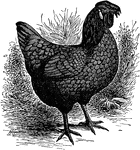
Blue Andalusian Hen
Andalusians are generally classified as "Mediterranean" chickens. They are relatively rare, and can…

Humpty Dumpty
Humpty Dumpty sat on a wall. Humpty Dumpty had a great fall; All the king's horses and all the king's…
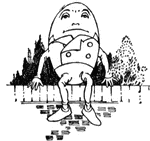
Humpty Dumpty
Humpty Dumpty sat on a wall. Humpty Dumpty had a great fall; All the king's horses and all the king's…
Insect Life Stages
Illustrated are the four stages in an insects' life: egg, larva, pupa, imago. The insect pictured is…
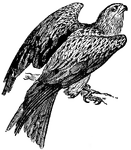
European Kite
European Kites are very miscellaneous feeders, but depend largely on offal, and in the eastern tropics…
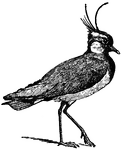
Lapwing (or Peewit)
A handsome plover-like bird of Northern Europe and Asia (Vanellus cristatus), also known in Great Britain…
!["[From left to right:] Snail-shell and Egg, Ostrea and Spondylus, Carinaria, Vitreous Carinaria." — Goodrich, 1859](https://etc.usf.edu/clipart/13900/13989/mollusca_13989_mth.gif)
Mollusca
"[From left to right:] Snail-shell and Egg, Ostrea and Spondylus, Carinaria, Vitreous Carinaria." —…

Mosquito Eggs
"Eggs of mosquitoes. A, Culex; B, Anopheles photographed on the water, natural size." —Davison,…

Myriapoda
"1 and 1, Egg and Larva of Iulus; 2, and 2, Iulus; 3, Polydesmus; 4, Glomeris; 5, Geophilus; 6, Lithobius;…
